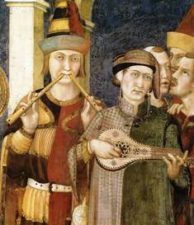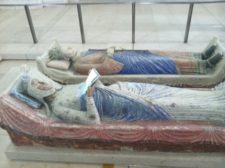I’ve been reading a biography of Eleanor of Aquitaine (1137-1152), which led me to the subject of troubadours.
 Troubadours were poets and musicians whose art form flourished mostly between the 11th and 13th centuries. They tended to be employed by a wealthy person, often for their whole careers, and mostly in the Provence region of medieval France. The subject of their lyric poetry was often about unrequited love, the love-sick poet pining for an unattainable lady. Every college English major knows this literary convention as “courtly love.”
Troubadours were poets and musicians whose art form flourished mostly between the 11th and 13th centuries. They tended to be employed by a wealthy person, often for their whole careers, and mostly in the Provence region of medieval France. The subject of their lyric poetry was often about unrequited love, the love-sick poet pining for an unattainable lady. Every college English major knows this literary convention as “courtly love.”
So what does all this have to do with Eleanor? One of the first famous troubadours was her grandfather, William of Aquitaine (1071 – 1127), who composed some pretty racy verse. This is but one cool fact about one of western Europe’s coolest women ever.
Eleanor would eventually become queen of two kingdoms (first France, then England), and mother of two kings. At fifteen, the fabulously wealthy Eleanor married her first husband, Louis. Soon to be crowned Louis VII, he was a super-religious dullard who worshipped his wife—from afar. His father died soon thereafter, and the couple was crowned king and queen of France.
Eleanor was bored with palace life. To give you an idea of the castle’s lack of creature comforts, a fireplace was installed after she moved in, to modernize it.
She had two daughters as queen of France, but she and Louis became increasingly estranged, and finally the Pope agreed to annul their marriage. Two months later, Eleanor married Henry, Count of Anjou and Duke of Normandy. Two years after that, they were king and queen of England. They had eight children together, but in 1167, they separated, possibly because of Henry’s multiple infidelities. Eleanor moved back to her own turf in Poitiers, and established The Court of Love, where she patronized artists and poets and the arts.
There’s so much more to her amazing life, but I wanted to focus on the troubadours and Eleanor’s role in their place in history.
Back in the English court, Eleanor had encouraged troubadours, which soon became part of medieval English society. One of the finest troubadours was Bernard de Ventadour, (sometimes spelled Bernart de Ventadorn). Eleanor brought him to the English court, where he composed cool stuff like this. He and Eleanor may also have had a love affair (some historians think it happened after her marriage to Louis ended and before Henry). Suffice to say, when he returned from a sojourn around his kingdom, Henry didn’t seem psyched to see the troubadour settled in at his English court.
Two summers ago I visited the abbey at Fontevraud, where Eleanor is buried. Here’s a patch of loveliness outside the abbey:
And here’s a picture I took of her, lying next to Henry. I love that she’s depicted reading a book. Their son, Richard the Lionheart, is also entombed there, or at least most of him is. His heart and other entrails were sent to a couple of other cathedrals in France.
Incidentally, there is a difference between a troubadour and a wandering minstrel. Here’s Monty Python’s example of the latter.
http://www.medieval-life-and-times.info/medieval-music/troubadours.htm
http://www.medievalists.net/2015/01/29/troubadours-part-sad-songs-say-much/